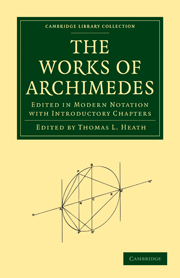Book contents
- Frontmatter
- PREFACE
- LIST OF THE PRINCIPAL WORKS CONSULTED
- Contents
- INTRODUCTION
- CHAPTER I ARCHIMEDES
- CHAPTER II MANUSCRIPTS AND PRINCIPAL EDITIONS—ORDER OF COMPOSITION—DIALECT—LOST WORKS
- CHAPTER III RELATION OF ARCHIMEDES TO HIS PREDECESSORS
- CHAPTER IV ARITHMETIC IN ARCHIMEDES
- CHAPTER V ON THE PROBLEMS KNOWN AS ΝΕΥΣΕΙΣ
- CHAPTER VI CUBIC EQUATIONS
- CHAPTER VII ANTICIPATIONS BY ARCHIMEDES OF THE INTEGRAL CALCULUS
- CHAPTER VIII THE TERMINOLOGY OF ARCHIMEDES
- THE WORKS OF ARCHIMEDES
CHAPTER VI - CUBIC EQUATIONS
Published online by Cambridge University Press: 07 September 2010
- Frontmatter
- PREFACE
- LIST OF THE PRINCIPAL WORKS CONSULTED
- Contents
- INTRODUCTION
- CHAPTER I ARCHIMEDES
- CHAPTER II MANUSCRIPTS AND PRINCIPAL EDITIONS—ORDER OF COMPOSITION—DIALECT—LOST WORKS
- CHAPTER III RELATION OF ARCHIMEDES TO HIS PREDECESSORS
- CHAPTER IV ARITHMETIC IN ARCHIMEDES
- CHAPTER V ON THE PROBLEMS KNOWN AS ΝΕΥΣΕΙΣ
- CHAPTER VI CUBIC EQUATIONS
- CHAPTER VII ANTICIPATIONS BY ARCHIMEDES OF THE INTEGRAL CALCULUS
- CHAPTER VIII THE TERMINOLOGY OF ARCHIMEDES
- THE WORKS OF ARCHIMEDES
Summary
It has often been explained how the Greek geometers were able to solve geometrically all forms of the quadratic equation which give positive roots; while they could take no account of others because the conception of a negative quantity was unknown to them. The quadratic equation was regarded as a simple equation connecting areas, and its geometrical expression was facilitated by the methods which they possessed of transforming any rectilineal areas whatever into parallelograms, rectangles, and ultimately squares, of equal area; its solution then depended on the principle of application of areas, the discovery of which is attributed to the Pythagoreans. Thus any plane problem which could be reduced to the geometrical equivalent of a quadratic equation with a positive root was at once solved. A particular form of the equation was the pure quadratic, which meant for the Greeks the problem of finding a square equal to a given rectilineal area. This area could be transformed into a rectangle, and the general form of the equation thus became x2 = ab, so that it was only necessary to find a mean proportional between a and b. In the particular case where the area was given as the sum of two or more squares, or as the difference of two squares, an alternative method depended on the Pythagorean theorem of Eucl. 1. 47 (applied, if necessary, any number of times successively).
- Type
- Chapter
- Information
- The Works of ArchimedesEdited in Modern Notation with Introductory Chapters, pp. cxxiii - cxliPublisher: Cambridge University PressPrint publication year: 2009First published in: 1897



